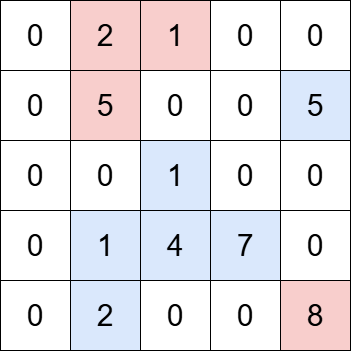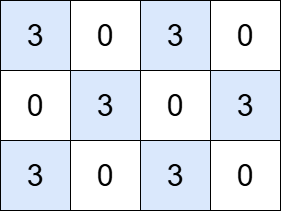LeetCode in Kotlin
3619. Count Islands With Total Value Divisible by K
Medium
You are given an m x n matrix grid and a positive integer k. An island is a group of positive integers (representing land) that are 4-directionally connected (horizontally or vertically).
The total value of an island is the sum of the values of all cells in the island.
Return the number of islands with a total value divisible by k.
Example 1:

Input: grid = [[0,2,1,0,0],[0,5,0,0,5],[0,0,1,0,0],[0,1,4,7,0],[0,2,0,0,8]], k = 5
Output: 2
Explanation:
The grid contains four islands. The islands highlighted in blue have a total value that is divisible by 5, while the islands highlighted in red do not.
Example 2:

Input: grid = [[3,0,3,0], [0,3,0,3], [3,0,3,0]], k = 3
Output: 6
Explanation:
The grid contains six islands, each with a total value that is divisible by 3.
Constraints:
m == grid.lengthn == grid[i].length1 <= m, n <= 10001 <= m * n <= 1050 <= grid[i][j] <= 1061 <= k <= 106
Solution
class Solution {
private var m = 0
private var n = 0
fun countIslands(grid: Array<IntArray>, k: Int): Int {
var count = 0
m = grid.size
n = grid[0].size
for (i in 0..<m) {
for (j in 0..<n) {
if (grid[i][j] != 0) {
val curr = dfs(i, j, grid)
if (curr % k == 0) {
count++
}
}
}
}
return count
}
private fun dfs(i: Int, j: Int, grid: Array<IntArray>): Int {
if (i >= m || j >= n || i < 0 || j < 0 || grid[i][j] == 0) {
return Int.Companion.MAX_VALUE
}
var count = grid[i][j]
grid[i][j] = 0
val x = dfs(i + 1, j, grid)
val y = dfs(i, j + 1, grid)
val a = dfs(i - 1, j, grid)
val b = dfs(i, j - 1, grid)
if (x != Int.Companion.MAX_VALUE) {
count += x
}
if (y != Int.Companion.MAX_VALUE) {
count += y
}
if (a != Int.Companion.MAX_VALUE) {
count += a
}
if (b != Int.Companion.MAX_VALUE) {
count += b
}
return count
}
}

